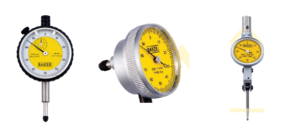Dial gauge/indicator a measuring instrument in which small displacements of a spindle or a lever are magnified by suitable mechanical means to a pointer rotating in front of a circular dial having a graduated scale.
Dial gauge indicators are also utilized as comparators in many fields.
There are 3 types of dial gauges:
- Dial indicators in which the spindle is parallel to the dial face
- Dial indicator in which the spindle is perpendicular to the dial face
- Dial indicators in which the measuring contact member is a lever.
These are also known as dial test indicators
We have listed the 7 critical uses of dial gauge indicators in this short yet informative layout. They are:
1. For Workpiece Alignment
Engineers use dial indicators for workpiece alignment in various machines including, but not limited to, milling machines, lathe machines, grinding machines, and EDM.
2. To Identify Lateral Run-out
Dial gauge indicators find significant application in automotive disc brakes where they are used to check lateral run-out. Engineers then reinstall the disc failing which can cause damaged studs and uneven torque.
3. For Calibrating Machines
Before the production even begins, dial indicators are used to calibrate the machines in the workshop. This phase is the first one in the manufacturing process used to ensure maximum accuracy in the output.
4. To Measure Height Difference
Narrow limits and the height difference between them are difficult to measure. This difference is where the role of dial gauge indicators comes in. They can measure such minute height differences with ease.
5. To Detect Deformations
In the manufacturing process, deformations such as compression and intension are bound to arise. However, it is equally important to identify and eliminate them using dial gauge indicators.
6. Checking Positional Errors
Dial indicators also find critical applications in detecting positional surface errors such as alignment, squareness, and parallelism.
7. Detect Geometrical Errors
Accurate geometry is imperative in the manufacturing process. This fact is why dial gauge indicators are used for determining errors in taper, roundness, and ovality.
When it comes to linear management, dial indicators are most preferred by engineers owing to their accuracy. Particularly in the manufacturing process, dial indicators have a pivotal role in determining accuracy and consistency. Moreover, they are also vital for the calibration or initial set-up of a machine.
Dial gauges are critical to an engineer due to their varied uses, as we’ve discussed. However, you also need to pick reliable ones from the market. That’s where we come in. At Baker Gauges, we offer a range of premium dial gauge indicators such as mechanical plungers, lever types, digital plungers, dial-depth gauges, universal test sets, and many other types just for you.


